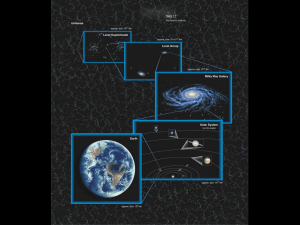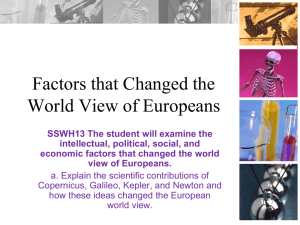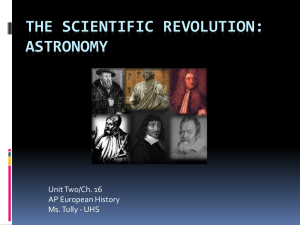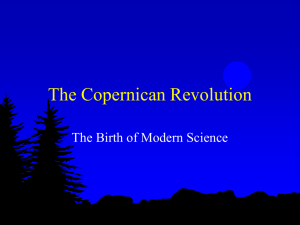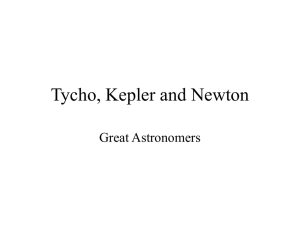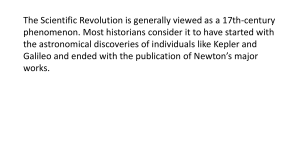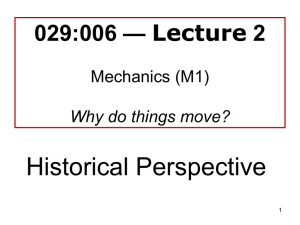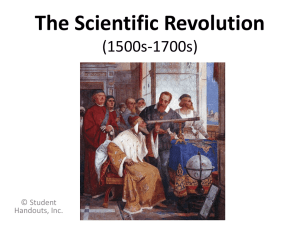Chapter 3 - Harding University
advertisement
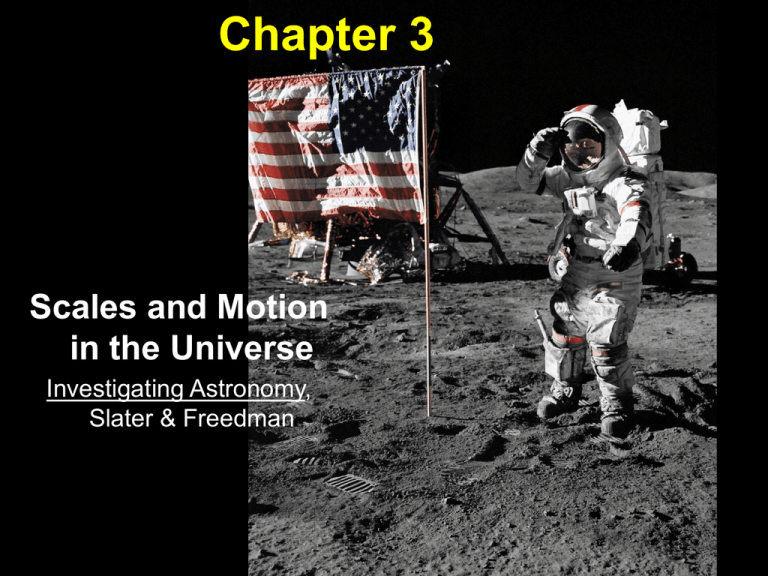
Chapter 3 Scales and Motion in the Universe Investigating Astronomy, Slater & Freedman In this chapter you will discover… • What makes a theory scientific • The scientific revolution that changed the idea of an unmoving Earth and allowed the Earth to move • Copernicus’s argument that the planets orbit the Sun • Why the direction of motion of the planets on the celestial sphere sometimes appears to change • That Kepler’s determination of the shapes of planetary orbits depended on the careful observations of his mentor Tycho Brahe • How Isaac Newton formulated an equation to describe the force of gravity and how he thereby explained why the planets and moons remain in orbit The Ancient Mystery of the Planets Our goals for learning: • What was once so mysterious about the movement of planets in our sky? • Why did the ancient Greeks reject the real explanation for planetary motion? Planets Known in Ancient Times • Mercury – difficult to see; always close to Sun in sky • Venus – very bright when visible — morning or evening “star” • Mars – noticeably red • Jupiter – very bright • Saturn – moderately bright Eratosthenes and Aristarchus Using simple tools and basic geometry to measure: 1. the size of the Earth, Moon, and Sun (310-~230 BC) 220? – 143? BC 2. the distances to the Moon and Sun 1st heliocentric theory Sun 18 to 20 x Moon distance Size of sun ~ 7x earth What was once so mysterious about planetary motion in our sky? • Planets usually move eastward from night to night relative to the stars. – You cannot see this motion on a single night; rather, planets rise in the east and set in the west. • But sometimes they go westward for a few weeks or months: retrograde motion Early models of the universe attempted to explain the motion of the five visible planets against the background of “fixed” stars. The main problem was that the planets do not move uniformly against the background of stars, but at times appear to stop, move backward, then move forward again. This backward motion is referred to as retrograde motion. Time-lapse images of Mars during retrograde Jupiter retrograde motion The retrograde motion of Mars as shown in a series of images taken on the same photographic plate. Explaining Apparent Retrograde Motion • Easy for us to explain: occurs when we “lap” another planet (or when Mercury or Venus lap us) • But very difficult to explain if you think the solar system is geocentric and the Earth is unmoving • In fact, ancients considered but rejected the correct explanation… We see apparent retrograde motion when we pass by a planet in its orbit. Why did the ancient Greeks reject the real explanation for planetary motion? • Their inability to observe stellar parallax was a major factor. The Greeks knew that the lack of observable parallax could mean one of two things: 1. Stars are so far away that stellar parallax is too small to notice with the naked eye 2. Earth does not orbit Sun; it is at the bottom of the universe With rare exceptions such as Aristarchus, the Greeks rejected the correct explanation (1) because they did not think the stars could be that far away… Thus setting the stage for the long, historical showdown between Earth-centered and Sun-centered systems. The most sophisticated geocentric model was that of Ptolemy (A.D. 100-170) — the Ptolemaic model: • Sufficiently accurate to remain in use for 1,500 years. • Arabic translation of Ptolemy’s work named Almagest (“the greatest compilation”) •Greeks also tended to Believe that planets were living beings influencing man’s life.. Ptolemy •Ptolemy’s book, Tetrabiblios, is the bible of astrology. The Ancient Greek Model An Earth-centered, or geocentric, model of the universe Ptolemy’s model used a geocentric (Earth-centered) model of the solar system in which the planets orbited the Earth indirectly by moving on epicycles which in turn orbited the earth. The Ptolemaic system was an ingenious and complicated system of circular orbits centered on other circular orbits called epicycles. It remained the best model for over 1500 years (with many modifications). Earth Centered Celestial sphere The assumptions for this model were The commonly accepted: 1. the earth did not move 2. the earth was the center of the system 3. the stars were located at a fixed distance on a transparent celestial sphere that rotated from E to W 4. the celestial realm was unchanging, and celestial motion was perfect, i.e. circular! The Marriage of Aristotle and Christianity • • In the 13th century St. Thomas Aquinas blended the natural philosophy of Aristotle, which included the Ptolemaic model, with Christian beliefs. A central, unmoving Earth fit perfectly with prevalent Christian thinking, and various scriptures where found, whose literal interpretation, seemed to agree with this model. o o o o 1 Chronicles 16:30: “He has fixed the earth firm, immovable.” Psalm 96:10: “He has fixed the earth firm, immovable ...” Psalm 104:5: “Thou didst fix the earth on its foundation so that it never can be shaken.” Isaiah 45:18: “...who made the earth and fashioned it, and himself fixed it fast...” Timeline of Ancient Astronomy Ptolemy’s system worked well in general detail. It was used to create tables predicting the occurrence of astronomical events.... eclipses conjunctions etc. Over several hundred years, small errors in the tables accumulated to produce large error in the timing of events - as much as a month by 1200 AD A major revision was done in 1250 by a group of scholars under King Alfonso of Spain. Ptolemaic system was modified to include deferents (off center circles). They produced the Alfonsine Tables By 1500 even these tables were in error by several hours and even days in some cases epicycle Epicycle with deferent center of epicycle Copernicus, a contemporary of Columbus, worked 40 years on a heliocentric—sun-centered—model for two reasons: (1) Ptolemy’s predicted positions for celestial objects had become less accurate over time. (2) The Ptolemaic model was not aesthetically pleasing enough. He wanted to restore perfect” or circular motion and get rid of off-center circles! Because both models (Ptolemaic & Copernican) were based on the assumption that the planets move at constant speed, Copernicus was forced to add small epicycles of his own to improve accuracy. Copernicus would not abandon the circle as the preferred planetary orbit because he thought circles are the best representation of the perfect motions of the heavens. Advantages of Copernican System: Simpler! [not more accurate!] simple explanation of retrograde motion explained the phases of Venus explained why Mercury & Venus always close to the sun Using trigonometry was able to calculate the relative distances to all visible planets Timeline of Renaissance Astronomy But What about the Scriptural Evidence for the Geocentric Model? • As more and more evidence began to build which indicated the correctness of Copernicus’ model, faithful Christians had to ask some fundamental questions about their interpretation of scripture. • By the end of the 17th century, most Christians had come to accept the heliocentric model. • These Christians had to make adjustments to their interpretation of certain scriptures: the Earth being “fixed” must be interpreted differently. The basic scriptural re-interpretation typically involved asking the question, “What is the scripture talking about in the verses interpreted previously as a fixed Earth”? The re-examination of scripture continues even today as we seek the message of scripture that God intended to deliver – which we have discovered is almost never scientific information. Comparing The Two Models There were strong argument against Copernican idea of a moving earth: Inertia-if earth is moving, why don’t objects thrown upward fall behind as the earth rotates under the object? Parallax-if earth moves, one should see stellar parallaxes (stars seem to move as viewed from different locations) Celestial Sphere Stellar parallax is quite small- 0.75 arcseconds for largest shift detected — because the stars are so far away from us. Stellar parallax, the apparent annual shifting of nearby stars with respect to background stars, was not observed until 1838. The Copernican Model had good Predictive Power A good model (or theory) will make verifiable predictions that might allow the the theory to be disproved. Using the Astronomical Unit (AU)— the average distance between Earth and Sun— Copernicus predicted with amazing accuracy the Sun-to-planet distances for the 5 planets visible from Earth in the 1500s. Planetary Distances in AU Copernicus Value Actual Value Mercury 0.38 0.39 Venus 0.72 0.72 Earth 1.00 1.00 Mars 1.52 1.52 Jupiter 5.22 5.20 Saturn 9.17 9.54 The Copernican model was more aesthetic since it could explain the motions of Mercury and Venus without resorting to special rules needed by the Ptolemaic model. Copernicus offered a simpler explanation for retrograde motion that required no use of epicycles. 16 Copernicus, who died in 1543 just as his book De Revolutionibus was published, started such an upheaval in people’s thinking that the word “revolution” took on a second meaning that is so familiar to us today. Tycho Brahe Tycho was born 3 years after Copernicus died. 17 Tycho Brahe Tycho built the largest and most accurate naked-eye instruments yet constructed. He could measure angles to within 0.1º, close to the limit the human eye can observe. 18 He not only made careful measurements, but he recorded the accuracy of each measurement. 1563 close conjunction of Jupiter & Saturn. Alfonsine tables were off by a month, while Copernican tables were off by several days. Tycho wanted to correct the tables 19 Woodcut of Tycho Silver nosepiece is visible in the picture Tycho lost the tip of his nose in a duel at age 20 over a question in math. 11/11/1572 Nova appeared in the sky and was closely observed by Brahe: he observed.... a. no apparent parallax, therefore the nova was not inside celestial sphere b. thus an obvious change in the unchanging celestial sphere Tycho writings about the Nova gained the attention/approval of Frederick, king of Denmark who built Tycho the world’s best observatory (Uraniborg) on island of Ven Tycho’s supernova today Woodcut of Tycho’s Stella Noveau Woodcut of the inside of Brahe’s observatory Blaeu ´s Atlas , 1663 Stjerneborg, 1584, partly underground Aerial view of site of Uraniborg on the Island Ven Sweden Denmark Poland After Frederick’s death, Tycho fell out of favor and thus disassembled his observatory and moved it to Prague under HRE Rudolph II Castle Benatky His commission was to revise Alfonsine tables Hired several mathematicians to handle the drudgery of the computations, one of whom was Johannes Kepler Tycho’s model Tycho Brahe died 24th October 1601 of a urinary bladder infection that he may have tried to cure himself, with a medicine containing mercury Teyn Church in Prague where Tycho was buried Body exhumed in 1901 to determine cause of death 1996 Particle Induced X-ray Emission (PIXE) showed recent high levels of Mercury in Brahe’s hair samples implying mercury poisoning. 1610 painting by unknown artist Born 1571 Died 1630 (58) Johannes Kepler Kepler was a sickly child of a protestant family living in predominantly catholic area. Got scholarship to become Lutheran minister, but liked math better. Had influential teacher who was a Copernican. Became Math teacher at Graz (not very good, only had 1 student last year) 1595 wrote almanac with astronomical & astrological weather predictions. They were correct and got reputation as astrologer In 1600, a year before Tycho died, Kepler accepted a position as Tycho’s assistant, working on calculations Tycho’s best data had been gathered for Mars. Based on circles and epicycles Kepler’s best Copernican model for Mars matched Tycho’s data to within 0.13º (8 arcminutes) [less than the accuracy of Tycho’s measurements]. When Brahe died in 1601, Kepler got his job, and after a fight with Brahe’s widow, got possession of Brahe’s notebooks of data The error in the position of Mars exceeded the error in Tycho’s measurements, which continued to bothered Kepler. Could get agreement within 8 arcmin, > Tycho data had a maximum error of 6 arcmin. Kepler was lifelong mystic, enamored with numbers (we would say a numerologist) In possession of Brahe’s data, Kepler spent more than 5 years pouring over the details, trying to reconcile the error. Kepler’s persistence finally led him to abandon circles and try other shapes. The shape that worked for Mars and all other planets was the ellipse. The Ellipse The ellipse is a geometrical shape every point of which is the same total distance from two fixed points (the foci). Eccentricity is the distance between the foci and its center divided by half the longest distance across (semi-major axis). sun focus The eccentricity of the ellipse measures the difference between the major and minor axes. e = c/a If the axes are equal, then e=0 and the ellipse becomes a circle. minor axis major axis c planet focus a All the planet orbits have e ~ 0.1 except Pluto (.248) and Mercury (.206) The center of force occupies one focus of the ellipse, while the other focus is usually empty Kepler also discovered what we call the Law of Equal Areas which showed that planets did NOT move at constant speeds in their orbits Kepler’s 2nd Law – the law of equal areas 1 month 1 month After more than 10 years further work, Kepler wrote a rather obscure and mystical book that showed a relationship between a planet’s orbit radius (a in AU) and its orbital period (P in years) P2 = a3 All of his discoveries are called Kepler’s 3 Laws of Motion In addition to the Laws of Motion, Kepler is also one of the 1st to try to give a physical reason for planets orbiting the sun. He thought that some type of magnetic force was responsible Galileo Galilei Born in Italy (1564), a contemporary of Copernicus. He was a Prof. at Padua in the Venetian Republic, & a Prof. at the University of Florence Strong believer in experimentation Strong, abrasive personality, popular writer who wrote in common Italian rather than Latin. He was very free to criticize and ridicule any who differed with him on any matter. Galileo Galilei and the Telescope • Galileo built his first telescope in 1609, shortly after hearing about telescopes being constructed in the Netherlands. • Galileo was perhaps the first person to use a telescope to systematically study the sky and record his observations. 1 Galileo made 5 important observations: Mountains and valleys on the Moon Sunspots More stars than can be observed with the naked eye Four moons orbiting Jupiter Complete cycle of phases of Venus • Though Galileo’s first three observations do not disprove the geocentric theory, they cast doubt on the the assumption of perfection in the heavens. The existence of stars too dim to be seen with the naked eye also cast doubt on the the fact that stars were all the same. In 1610, Galileo discovered four “stars” that move back and forth across Jupiter. He concluded that they are four moons that orbit Jupiter just as our Moon orbits Earth. These observations made by Jesuits in 1620 of Jupiter and its four visible moons. Galileo observed that Venus goes through a full set of phases: full, gibbous, quarter, crescent. Venus’s full set of phases can be explained by the heliocentric theory. The Ptolemaic theory predicts that Venus will always appear in a crescent phase, which is not borne out by the observations. Venus’ Phases in Ptolemy’s Model Galileo is also the first person to do any systematic study of motion and was the first person to understand the concept of inertia Galileo did a wide variety of experiments, even attempting to measure the speed of light by using lanterns on distant hilltops (concl. either infinite or too large to measure) Isaac Newton • Galileo is credited with setting the standard for studying nature through reliance on observation and experimentation to test hypotheses. • The year Galileo died—1642—is the year Isaac Newton was born. • Newton took the work of Galileo and Kepler and created an expansive theory of motion. 6 Isaac Newton (1642–1727) Isaac Newton was undeniably one of the greatest/most influential scientists that ever lived. Very religious man who believed the order in the universe was representative of God Very cautious person who had to be persuaded by his friends to publish ANY of his work • 1665-67 plague in London, Newton left the university and went to his country home for a year. While there he: – developed basic ideas of mechanics – basic concepts of gravity – beginning ideas on light and optics 1687 published Principia ( perhaps the most influential scientific book ever published) In it he explained the motion of the planets, comets using his law of gravity and his 3 Laws of Motion. He also derived Kepler’s Laws Could not solve the problem of gravitational attraction on a planet so he invented Calculus to solve it Published a book Optiks giving the basic ideas of geometrical optics, light, and color, including the fact that white light is made up of different colors To understand the motion of objects under the influence of gravity, we use the ideas of Isaac Newton and his 3 Laws of motion. The first concept needed is the idea of INERTIA. This was the concept not understood by ancient observers in their arguments against a moving earth..... “toss object in the air, if the earth is moving then the object will fall behind its launch point...” While not the first person to properly conceive of inertia, Galileo was the first to arrive at his views based on actual experiments he performed. Galileo’s work provided the basis for Newton’s formulation of the Law of Inertia. Inertia is the property of an object whereby it tends to maintain whatever velocity it has. The inertia of an object is determined by it MASS. • Newton’s First Law (Law of Inertia): Unless an object is acted upon by a net, outside force, the object will maintain a constant speed in a straight line. Note: a speed of zero (rest) is a constant speed. 7 Block continues to move when the cart suddenly stops due to the inertia of the block! Newton’s Second Law says that the acceleration of an object depends on the force applied to it and on its mass! • Acceleration is inversely proportional to the mass being accelerated. • What does “inversely proportional” mean? – As the mass gets bigger, the acceleration gets smaller 10 If an objects speed or direction of motion changes (like the block) - we say that the object is accelerated! • Acceleration is a measure of how rapidly the speed or direction of motion of an object is changing. • An object at rest has a speed of zero. • Newton’s first law says that a force is needed to change the speed and/or direction of an object’s motion. 8 V=0 No force means no acceleration! Car remains at rest (law of inertia) V>0 F The longer the force acts, the longer the car accelerates and the faster it goes If an unbalanced force is applied, the car accelerates and its speed increases >0 V>>0 F V>>>0 F An Important Digression — Mass & Weight Mass is the quantity of inertia an object has. Produced by particles from which it is made • Mass is NOT volume or weight. • Weight is the force of gravity. • The international (SI) unit of mass is the kilogram. • A kilogram on Earth weighs about 2.2 pounds. 9 Acceleration = force divided by mass In symbols A = F/m Often as Force = mass X acceleration or F = mA If the left side = 0 then right side is also = 0 Thus when the net force is zero, there is no acceleration. A = F/m if the force is large then Acceleration is large: A = F m if the mass is large then acceleration is small A = F m Newton’s Third Law • Third Law: When object X exerts a force on object Y, then object Y exerts an equal and opposite force back on X. X Y X pushes on Y Y pushes on X X Y The forces are equal in size and opposite in direction 11 The Third Law is sometimes stated as “For every action there is an opposite and equal reaction,” but the first statement is more precise in terms of physical forces. REMEMBER: The two forces ALWAYS act on DIFFERENT objects. Also there is no such thing as a single force!! Motion in a Circle • Motion of an object in a circle at constant speed (uniform circular motion) is an example of acceleration by changing direction. • Centripetal (“center-seeking”) force is the force directed toward the center of the curve along which the object is moving. 13 The most common force to discuss while studying the motion of planets, comets, stars, galaxies, and other such objects (including balls, etc. on the Earth) is GRAVITY. As the Earth orbits the sun, the force of gravitational attraction from the Sun pulls on the Earth Velocity at a and velocity at b are NOT the same – have diff. directions a velocity b velocity The Earth is accelerated continuously in its orbit! The Law of Universal Gravitation • This law states that between every two objects there is an attractive force, the magnitude of which is directly proportional to the mass of each object and inversely proportional to the square of the distance between the centers of the objects. 14 In equation form: GM2 M 1 F 2 D G is a constant, m1 and m2 are the masses, and d is the distance between their centers. Two objects that have mass are attracted to each other. M1 M2 F1 F2 D F1 & F2 are equal except for direction! Weight is the gravitational force between an object and the planetary body on which the object is located. mass Weight : pull of planet on object Earth mass W = mg Pull of gravity on a mass on Earth – known as weight Points approx. toward the center of the Earth or what we call DOWN –According to Newton, gravity…. --- makes objects fall to Earth --- keeps the Moon in orbit around the Earth ---- keeps the planets in orbit around the Sun –He could therefore explain the planets’ motions and why Kepler’s laws worked. The pull of the Earth’s gravity could be tied in with the orbit of satellites (such as the Moon) around the Earth. Newton made an argument to show this that is now known as Newton’s Cannon! Applet Newton’s Laws and Kepler’s Laws • Kepler’s first law—the planets move in elliptical orbits—can be derived from Newton’s laws but requires calculus. • Kepler’s second law—planets sweep out equal areas in equal times—can also be derived from Newton’s laws. As planets orbit the Sun they show a change in both speed and direction. 20 Newton and Kepler’s 3rd Law • Newton showed mathematically that Kepler’s third law—the perioddistance relationship—derives from the inverse square law for gravitation. • Newton modified Kepler’s third law, showing that mass is an important factor. a3 p2 =kM Where a is in meters and p is in seconds k is a constant and M is mass in kilograms 21 The Center of Mass Seesaw principle • Center of mass is the average location of the various masses in a system, weighted according to how far each is from that point. The CM is sometimes called the center of gravity. • Barycenter is the center of mass of two astronomical objects revolving around one another. 22 •The barycenter for the Earth-Moon system is inside the Earth, 4641 km from its center and inside its 6378 km radius • The location of the center of mass of the Earth-Moon system was determined by observing parallax of nearby planets due to the Earth’s motion as the Moon went around. 23 Using Newton’s Laws of Motion allows us to understand the general features of satellite motion, such as the moon, or any other orbiting satellite. Careful measurements of the orbits and periods of satellites (natural and man-made) allow one to accurately determine the mass of the body being orbited. One of the crowning achievements of Newton’s gravitational law was the discovery of Neptune. After it’s accidental discovery, the orbit of Uranus was analyzed using Newton’s Laws and the Law of Gravity. Despite careful measurements, the observed orbit did not match the one predicted by Newton’s Laws. Uranus & 3 moons The discrepancies were attributed to another unknown mass orbiting outside Uranus’ orbit. Using these results, the mass and location of the unknown object was predicted. Neptune & 1 moon Assuming Newton was correct, the discrepancies could only be explained by another planet, about the same size, orbiting outside of the orbit of Uranus. Gravity Works at All Scales This figure shows a few of the effects of gravity here on Earth, in the solar system, in our Milky Way Galaxy, and beyond. The Importance of Newton’s Laws • Kepler’s laws can be derived from them. • They explain tides and precession. • Their use predicted the existence of the planet Neptune. • They provide a way to measure things quantitatively and predict the motion of things. • Newton laid the foundation for our concept of the Universe. 32 Beyond Newton: How Science Progresses • Newton proposed that inertial mass was equivalent to gravitational mass, but he had no idea why. Subsequent measurements confirmed this coincidence. • Einstein in his General Theory of Relativity showed mathematically that the two types of masses are indeed equivalent. 33 This coincidence was one of the seeds leading Einstein to the development of the General Theory of Relativity The End Next, Chpt. 4 Exploring Our Evolving Solar System
